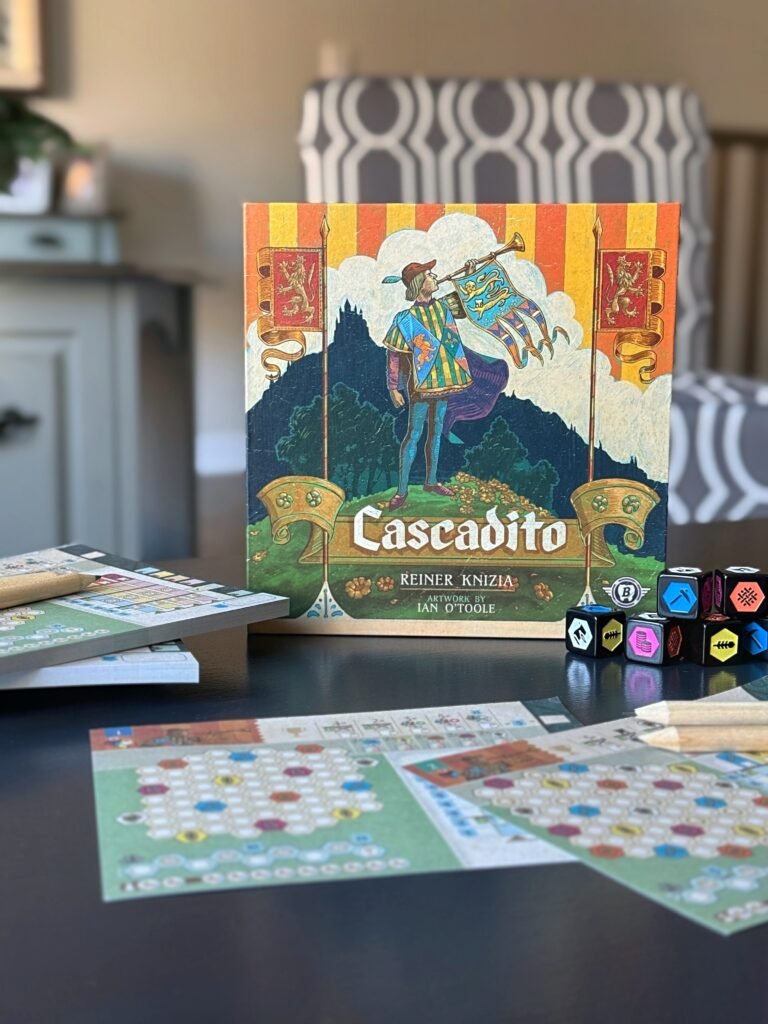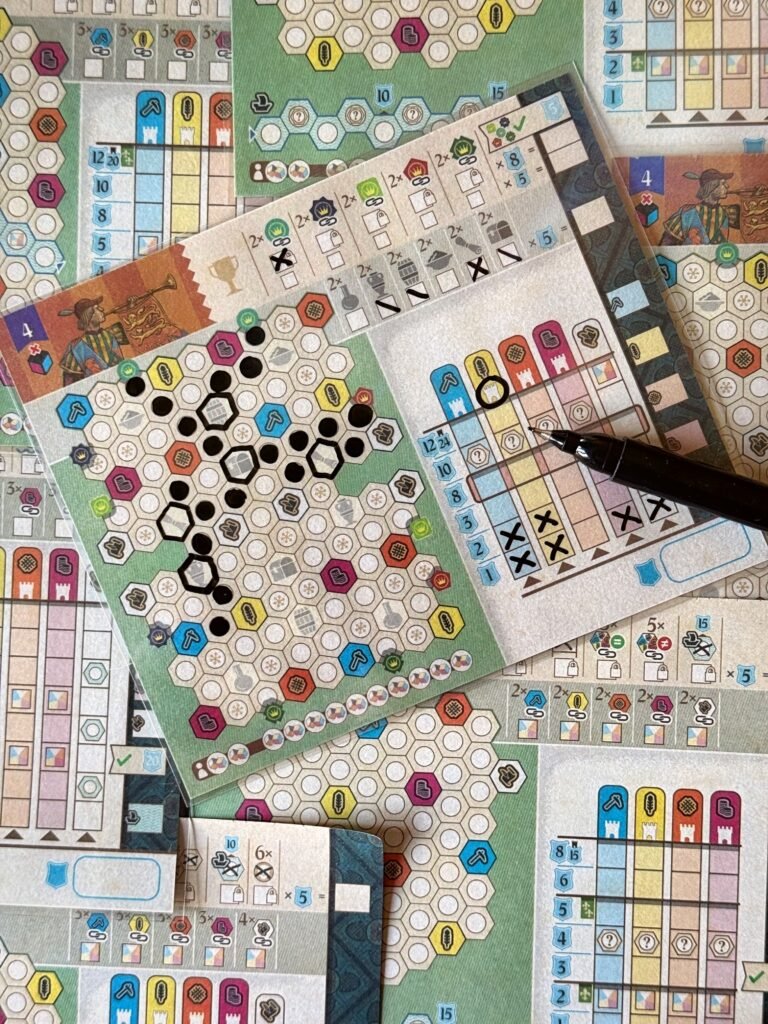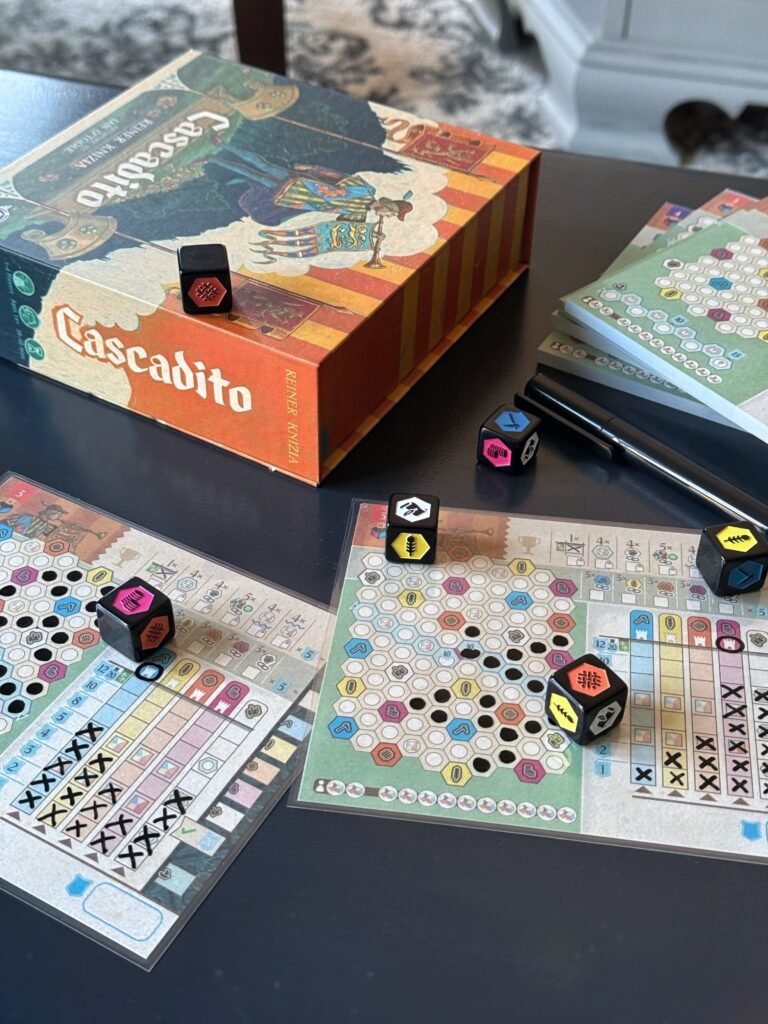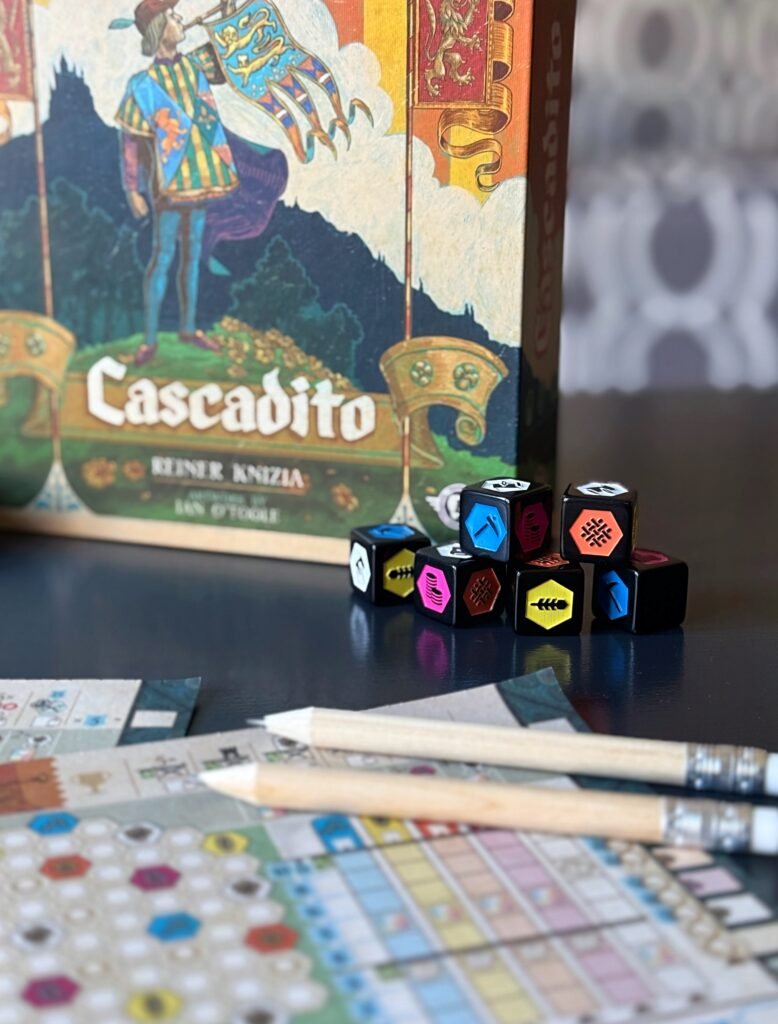Just You and A Pencil
Roll-and-writes manage to be both meditative and mentally crunchy, letting you disappear into your own little puzzle without ever really disappearing from the room. Chase satisfying combos, unlock bonuses, and optimize your way into feeling like a clever little genius, all while barely speaking to each other.
Part of the appeal is how lackadaisical they are by nature. Minimal setup, minimal teardown, just you, a sheet, some dice, and a pencil. While you’re heads-down connecting paths and plotting your next move, the table hums with quiet focus. And then comes the best part: the end-game autopsy, when everyone emerges from their own private brain-spiral to share their cleverest chains, biggest regrets, and tiny triumphs. It’s introspective, but not isolating.
The Designer Draw
So when we saw Cascadito, a roll-and-write designed by Reiner Knizia with art by Ian O’Toole, we had to peek inside. That kind of pedigree earns at least a couple of plays.
A Soft Puzzle with Gentle Ripples
But this isn’t a flashy showstopper. You connect towns by dispatching envoys across a map. Each turn, you draft a die and mark a space adjacent to a matching-coloured city. Reach a town, and you climb its track. Land on a bonus space, and you might trigger a chain of effects.

You’ll juggle five city colours (four, at first), using them to build networks and climb tracks while fulfilling public and private objectives along the way. The public goals add a hint of competition in a race format, but it feels more like a polite jostle than a brawl.

Maps, Maps, and More Maps
There’s nothing groundbreaking in the gameplay loop. It follows the familiar “pick a die, bubble in a space” pattern seen in many roll-and-writes. What makes Cascadito shine is its structure. Four unique maps subtly shift your priorities without adding any real rules overhead. One introduces trade goods, another brings in bandits, and another features a wide river to navigate. The changes are thoughtful rather than overwhelming.
It scratches that campaign itch without demanding a full-time commitment. You can wander in and out at your leisure.
The Tempo Teeters
And yet, for all the fun we had, it’s not without some oddities.
The turn structure should be seamless. Roll the dice, draft one, mark a space, repeat. Sometimes, the game flows nicely. Everyone grabs a die, dives into their maps, and things move along smoothly. Other times, the tempo lurches. Turns stretch. Eyes glaze. Someone inevitably asks, “Wait, is it my go?” The rhythm swings between brisk and glacial, especially at two players, where even mild indecision can turn into a coffee break.
You could enforce strict turn-taking to reduce confusion, but that only draws attention to how little your opponents’ actions affect you. You’re not waiting for someone to change the state of the board. You’re waiting for them to scribble. And if they’re mid-combo, unlocking bonuses and additional actions, you might be waiting a while. (Corinna isn’t the patient type.)
This almost-simultaneous play is also what makes shared objectives feel a bit murky. Who got there first? Did they take longer to play their turn, giving you a false sense of opportunity to claim the same goal? With more players, it becomes especially blurry. Achievements are often claimed mid-turn or retroactively, and roll-and-writes are notoriously allergic to clean undos. “Wait… when did you do that?” becomes a regular saying.
The game wants you to care. It wants you to watch your opponents, delay drafting until their turn is done, and time your moves with precision. But that level of engagement clashes with how breezily most turns unfold. The interaction technically exists, but it feels more like a thread you keep meaning to tug and keep forgetting about.

So, Would We Play It Again?

Still, even with the fuzziness and the fiddly timing, we kept playing.
Why? Because it’s fun. Cascadito delivers that cozy little dopamine rush you want from a roll-and-write. The combos are restrained but satisfying. There’s no need for tokens or scratchpads to track your moves. Everything stays in your head, and if you forget something, that becomes part of the ambiance too. If that sounds infuriating, this probably isn’t your game. But if you can shrug off the occasional flub or mis-scored goal, you’ll find a lot to enjoy.
We found ourselves craving the next map. We wondered how we would shift our priorities and wanted another shot at that neglected river path. The puzzle is personal. The structure is familiar. The four maps offer just enough variety to keep things fresh without stretching the ruleset thin.
The charm lies in the different maps and trying to solve each one with whatever the dice happen to offer.
Final Thoughts
Cascadito isn’t here to wow a table or reinvent a genre. But it will get played. And replayed. It is the kind of game that slips into your night like a quiet side dish. Low effort, full of little delights, and satisfying in its own modest way.
And when you’re low on spoons but still want to feel clever for a while, this is exactly the kind of game that earns its place on the shelf. Even if you forget to mark off half the objectives.
Corinna’s Rating: 8.1
Duncan’s Rating: 8.4
Note: a copy of this game was sent for review from the publisher. All thoughts and opinions are our own.


Leave a Reply